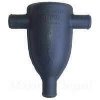Since I lately tried to sell a advanced reef ready tank, I was suprised by the number of people who really had no idea what I was talking about! As a result, I'm going to post a few pictures of a few things, mostly for your newer folks. (You can still buy my tank too,after, if you want!)
This first photo shows 2 different size hole saws, one that fits a 3/4 bulkhead (1" hole) and one that fits a 1" bulkhead (1.5" hole). When you drill a tank, bulkheads are used to allow you to attach your plumbing. This tank was drilled, but never plumbed, so I bought some 3/4" plugs and threaded them into the bulkheads. That is what you see in the photo. You can see also the nut and gasket for the bulkhead. The bottom image is of a attached bulkhead on the painted black back surface of my 65.
This first photo shows 2 different size hole saws, one that fits a 3/4 bulkhead (1" hole) and one that fits a 1" bulkhead (1.5" hole). When you drill a tank, bulkheads are used to allow you to attach your plumbing. This tank was drilled, but never plumbed, so I bought some 3/4" plugs and threaded them into the bulkheads. That is what you see in the photo. You can see also the nut and gasket for the bulkhead. The bottom image is of a attached bulkhead on the painted black back surface of my 65.






